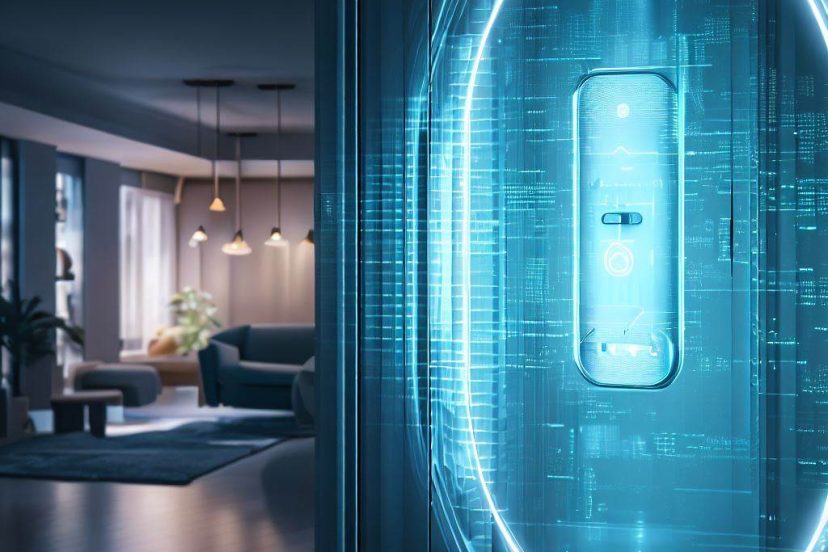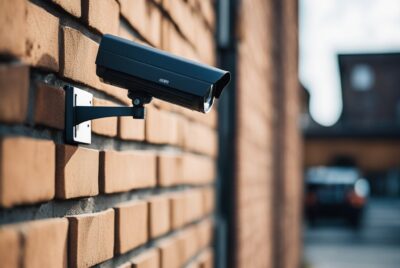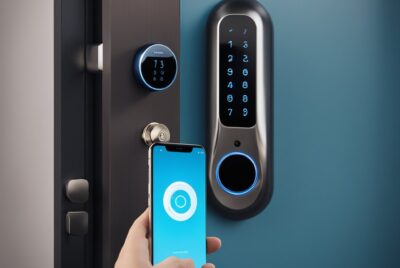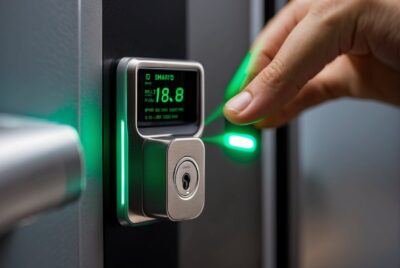Security Doors for Homes – Full Overview
*We may earn a commission for purchases made using our links. Please see our disclosure to learn more.
Security Doors for Homes: Enhancing Your Residential Safety
In my experience, security doors for homes are a vital investment for enhancing home security. Homeowners select these reinforced barriers as their first line of defense to prevent intrusions and protect against environmental hazards. Typically crafted from strong materials like steel or aluminum, security doors offer superior strength compared to standard doors. They are constructed with features such as multi-point locking systems, which provide added security. Moreover, many include tamper-proof hinges that are concealed, reducing the risk of forced entry.

My understanding is that the functionality of security doors extends beyond security. They can also contribute to a home’s aesthetic appeal with a variety of designs available to complement different architectural styles. Manufacturers offer these doors in an expansive range of options, ensuring that they meet both the safety requirements and the design preferences of homeowners. It’s clear that when choosing a security door, it’s not just about picking a barrier; it’s about selecting a product that integrates seamlessly with your home’s design while fortifying it against potential breaches.
Essentials of Security Doors

When it comes to protecting your home, the right choice of a security door is a fundamental consideration. I’ll guide you through the primary materials used in security doors and the significance of sturdily built locks and hinges.
Material Advantages and Choices
The foremost factor in a security door’s effectiveness is the material used in its construction. Here are the common materials I find most effective:
- Steel: Known for its strength and durability, steel is a top choice for front door security. A door made of steel, especially thick gauges like 22-gauge, offers enhanced resistance against forced entry.
- Aluminum: While lighter than steel, aluminum security doors often have a robust framework and are paired with metal alloys to boost strength without compromising aesthetic appeal.
- Wood Door: Wood in its solid form can provide a decent level of security. However, it is not as resistant as metal and may require additional reinforcements.
- Fiberglass Doors: These can mimic the look of wooden doors with increased resistance to wear and are less likely to warp or crack.
Each material has its own set of benefits, such as steel’s superior strength or aluminum’s corrosion resistance. The choice often depends on a homeowner’s specific security needs and aesthetic preferences.
Locks and Hinges
Locks and hinges are the critical components that work in conjunction with the door material to provide overall security.
- Smart Locks: Smart locks provide an advanced level of security with features like remote access, biometric entry, and tamper alerts.
- Deadbolt Lock: A high-quality deadbolt lock, ideally grade 1, is essential for front door security. Its sturdy bolt mechanism is harder to compromise compared to standard locks.
- Tamper-proof Hinges: Hinges are often targeted by intruders for tampering and removal. Security doors with hidden or protected hinges prevent this sort of attack.
Here’s a quick look at the lock and hinge specifications that I find most reliable:
| Component | Specification |
| Smart Locks | Remote access, biometric entry, tamper alerts |
| Deadbolt Lock | Grade 1 certification, solid metal construction |
| Hinges | Hidden or non-removable pins, heavy-duty construction |
Investing in quality locks and hinges is integral to reinforcing the door’s protective capabilities.
Types of Security Doors

When I consider upgrading home security, the type of security door is an essential factor. It’s crucial to understand the different types available and their specific features to make an informed decision.
Screen Security Doors
Screen security doors are particularly effective for maintaining visibility and air flow while still enhancing home security. These doors usually feature a steel or aluminum construction with a grid of metal mesh, offering a sturdy barrier without compromising on aesthetic appeal. The mesh is often made from steel which is not only durable but also resistant to cuts and break-ins. For added security, these doors typically come with a welded steel frame that firmly holds the mesh screen in place and is difficult for intruders to defeat.
Storm Doors and Their Features
Storm doors go another step by combining security with protection against harsh weather. They generally incorporate strong materials such as fiberglass, tempered glass, or steel. An important aspect of storm doors is their energy efficiency; many storm doors are designed to help insulate the home, with materials like fiberglass and mineral wool contributing to this. Additionally, some storm doors come with interchangeable glass and screen panels to adapt to changing seasons while providing robust security.
Enhancing Aesthetics and Functionality

When discussing the integration of security doors into my home, I place considerable emphasis on ensuring that their design complements the architectural style while meeting my safety needs.
Design and Curb Appeal
For me, opting for a Viz-Pro Quick Mount security door is one of the best solutions, as it offers an installation that is not only rapid but also reliable. It is essential that the door I choose provides an elegant entrance to the house without appearing overly fortified. The door handles play a significant role in the overall look, so I always go for a satin finish—it gives that sleek appeal and feels pleasant to the touch.
The curb appeal of my home is a reflection of my personal style. I prefer an openwork steel design for my security door, which merges security with artistic flair. The openwork allows light to pass through and softens the overall aesthetic, preventing a heavy, fortress-like appearance. I’ve found that a door with lightweight construction is advantageous because it’s both functionally efficient and easy to operate without sacrificing strength.
Key Features of My Preferred Security Doors:
| Feature | Description |
| Viz-Pro Quick Mount | Ensures swift, secure installation. |
| Door Handle | Satin finish for style and functionality. |
| Curb Appeal | Complements home’s exterior, enhancing visual appeal. |
| Openwork Steel | Blend of security and elegance, allows light through. |
By carefully selecting a security door that embodies these characteristics, I can protect my home confidently, without detracting from its visual attractiveness or functionality.
Security System Integration

When I look at modern home security, the integration of security doors within a home security system is crucial for both safety and convenience. This integration allows for handling emergencies more efficiently, providing an intelligent response to potential threats like forced entry or intrusions.
Smart Home Compatibility
The core of a well-integrated security door system lies in its ability to communicate with other devices in a smart home environment.
- Security Cameras: My security door should interface seamlessly with security cameras, allowing for real-time monitoring and recording of entry points.
- Forced Entry: In the event of forced entry, a well-integrated door will not only resist the intruder but also trigger an alarm and alert me or a monitoring service.
- Intruders: With the right setup, I can receive notifications on my phone if an intruder attempts to tamper with the security door.
- Home Security System: My security door should act as a part of the larger ecosystem, contributing to the overall safety measures. Integration ensures that all security components, including smart locks, work together in harmony.
- Smart Locks: These devices should allow for remote locking and unlocking, providing both security against unauthorized access and convenience for authorized individuals.
By integrating my security door with the home’s security system, I enhance the protective measures while maintaining the aesthetic and functional aspects of the doorway. Compatibility with smart home technologies ensures that my home remains a safe, intelligent, and responsive environment.
Purchasing and Installation

When I decide to enhance my home’s security with a new door, I consider both the cost of the door itself and the installation service. Proper installation is crucial for the door to function effectively as a security feature.
Understanding Pricing and Terms
When it comes to purchasing a security doors for homes, prices vary based on the material, design, and security features. On average, a basic security screen door can start from around $50, with more robust options climbing to $600 or more. I find it important to compare store prices and check for seasonal discounts or promotions, especially at large retailers like Home Depot. Meanwhile, professional installation costs typically range between $275 to $425.
- Budget-friendly options are available but may have limitations in terms of durability or design complexity.
- Reversible doors, which can swing in or out, can be at the higher end of pricing due to their added versatility.
- It’s wise for me to review terms of use and warranties before committing to a purchase.
- Prices listed by local stores often compete with Home Depot and might offer better deals or personalized services.
- Remember that while some doors include locks, others sell them separately, costing anywhere between $200 to $600.
I always ensure that the final price I’m considering includes all necessary components, as it’s essential to avoid unexpected costs during installation.
Frequently Asked Questions
In this section, I’ll be addressing common inquiries homeowners have while considering security doors. These questions delve into different aspects such as selection criteria, enhanced protection, key features, cost variations, and the pros and cons of security doors.
1. What factors should be considered when selecting residential steel security doors and frames?
When selecting residential steel security doors and frames, I consider the door’s material strength, frame durability, and the compatibility with my home’s existing decor. I also assess the door’s resistance to weather and potential intruders.
2. How do metal security screen doors enhance protection for homes?
Metal security screen doors enhance home protection by providing a sturdy barrier that’s difficult to breach. These screen doors also allow visibility and airflow while maintaining a secure environment within my home.
3. What features do the best security doors for homes typically include?
The best security doors for homes typically include heavy-duty frames, tamper-resistant locks, and reinforced corners. They might also have features such as multi-point locking systems and peepholes or cameras for increased surveillance.
4. Can security storm doors with glass and screen offer adequate protection?
Security storm doors with glass and screen can offer ample protection if they are made with tempered or laminated glass and have a strong frame. These doors can withstand harsh weather while deterring unauthorized entry.
5. What are the benefits and drawbacks of installing a security door?
Installing a security door benefits me by increasing my home’s security, potentially deterring burglaries, and improving energy efficiency. However, drawbacks could include a higher upfront cost and the necessity for professional installation to ensure effectiveness.




